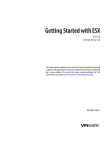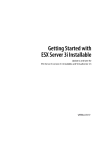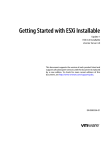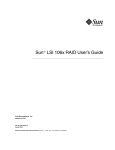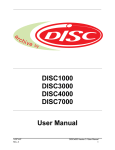Download Getting Started with ESXi Installable - ESXi 4.0 Installable
Transcript
Getting Started with ESXi Installable ESXi 4.0 Installable vCenter Server 4.0 This document supports the version of each product listed and supports all subsequent versions until the document is replaced by a new edition. To check for more recent editions of this document, see http://www.vmware.com/support/pubs. EN-000119-02 Getting Started with ESXi Installable You can find the most up-to-date technical documentation on the VMware Web site at: http://www.vmware.com/support/ The VMware Web site also provides the latest product updates. If you have comments about this documentation, submit your feedback to: [email protected] Copyright © 2011 VMware, Inc. All rights reserved. This product is protected by U.S. and international copyright and intellectual property laws. VMware products are covered by one or more patents listed at http://www.vmware.com/go/patents. VMware is a registered trademark or trademark of VMware, Inc. in the United States and/or other jurisdictions. All other marks and names mentioned herein may be trademarks of their respective companies. VMware, Inc. 3401 Hillview Ave. Palo Alto, CA 94304 www.vmware.com 2 VMware, Inc. Contents Updated Information 5 Getting Started with ESXi Installable 7 Getting Started Tasks 7 ESXi Installation 8 ESXi Hardware Requirements 8 Install ESXi 4.0 9 Setting Up ESXi 10 Set the Password for the Administrator Account 10 Configuring IP Settings for ESXi 11 Configure IP Settings from the Direct Console 11 Configure DNS Settings from the Direct Console 12 Managing Your First ESXi Host 13 vSphere Client Hardware Requirements 13 vSphere Client Software Requirements 13 Download the vSphere Client 13 Install the vSphere Client 14 Start the vSphere Client and Log In to ESXi 15 Add Your First Virtual Machine by Importing a Virtual Appliance Managing Multiple Hosts with vCenter Server 17 vSphere and vCenter Server 17 vCenter Server Installation 18 Setting Up a Basic Inventory with the Getting Started Tabs 23 Start the vSphere Client and Log In to vCenter Server 23 Create a Datacenter 24 Add a Host 25 Create a Virtual Machine 26 Where to Go Next 27 The vSphere Tutorial 27 vSphere Documentation 27 15 Index 29 VMware, Inc. 3 Getting Started with ESXi Installable 4 VMware, Inc. Updated Information Getting Started with ESXi Installable is updated with each release of the product or when necessary. This table provides the update history of Getting Started with ESXi Installable. Revision Description EN-000119-02 n n Removed the text " No outbound traffic is allowed through the assigned IP address." from “Configuring IP Settings for ESXi,” on page 11 section. Minor change in “vCenter Server Prerequisites,” on page 19 section EN-000119-01 “ESXi Hardware Requirements,” on page 8 now reflects that HP Smart Array RAID controllers are supported with ESXi. EN-000119-00 Initial release. VMware, Inc. 5 Getting Started with ESXi Installable 6 VMware, Inc. Getting Started with ESXi Installable Get started with ESXi quickly with this information about installation and initial setup. Follow the procedures included here to install and set up a basic inventory for a single-host virtualization environment. After your host is set up with a working virtual machine, you can install vCenter Server and explore a multiple-host virtualization environment. This information is for experienced Windows or Linux system administrators who will be installing VMware ESXi Installable to deploy virtualization for the first time. Specifically, it is for users who meet the following requirements: n Do not yet have the ESXi software installed n Do not yet have the vSphere Client or VMware vCenter Server installed. Getting Started Tasks The getting started tasks take you from initial setup of a new virtualization host to a working virtual machine. After you have a host and functional virtual machine, you can set up a managed host environment with vCenter Server. Getting started with ESXi includes the following tasks: n Installing ESXi Installable and adding the host to your network n Installing the vSphere Client and connecting to the ESXi host n Deploying and running a virtual machine Completing the getting started tasks sets up the single-host management system for virtualization as shown in Figure 1. Figure 1. Basic Single-Host Management System After the initial setup of ESXi, you can deploy vSphere 4.0 with vCenter Server to manage multiple hosts. VMware, Inc. 7 Getting Started with ESXi Installable ESXi Installation Install ESXi to get started with running virtual machines. The machine running ESXi virtualization software acts as a host in your virtual infrastructure. Hosts provide CPU and memory resources, access to storage, and network connectivity for the virtual machines that reside on them. ESXi Hardware Requirements Make sure the host meets the minimum hardware configurations supported by ESXi 4.0. You need the following hardware and system resources to install and use ESXi 4.0: n Supported server platform (for a list of supported platforms, see the Systems Compatibility Guide) n VMware ESXi 4.0 will only install and run on servers with 64-bit x86 CPUs. n Known 64-bit processors: n All AMD Opterons support 64 bit. n All Intel Xeon 3000/3200, 3100/3300, 5100/5300, 5200/5400, 7100/7300, and 7200/7400 support 64 bit. n All Intel Nehalem (no Xeon brand number assigned yet) support 64 bit. n 2GB RAM minimum n One or more Gigabit or 10Gb Ethernet controllers. For a list of supported network adapter models, see the Hardware Compatibility Guide at http://www.vmware.com/resources/compatibility. n One or more of the following controllers (any combination can be used): n Basic SCSI controllers – Adaptec Ultra-160 or Ultra-320, LSI Logic Fusion-MPT, or most NCR/Symbios SCSI. n RAID controllers – Dell PERC (Adaptec RAID or LSI MegaRAID), HP Smart Array RAID, or IBM (Adaptec) ServeRAID controllers. n SCSI disk or a local (non-network) RAID LUN with unpartitioned space for the virtual machines. n For Serial ATA (SATA), a disk connected through supported SAS controllers or supported on-board SATA controllers. NOTE You cannot connect a SATA CD-ROM device to a virtual machine on an ESXi 4.0 host. To use the SATA CD-ROM device, you must use IDE emulation mode. ESXi 4.0 Installable supports installing on and booting from the following storage systems: n SATA disk drives – SATA disk drives connected behind supported SAS controllers or supported on-board SATA controllers. Supported SAS controllers include: n LSI1068E (LSISAS3442E) n LSI1068 (SAS 5) n IBM ServeRAID 8K SAS controller n Smart Array P400/256 controller n Dell PERC 5.0.1 controller Supported on-board SATA include: n 8 Intel ICH9 VMware, Inc. Getting Started with ESXi Installable n Nvidia MCP55 n ServerWorks HT1000 NOTE ESXi does not support using local, internal SATA drives on the host server to create VMFS datastores that are shared across multiple ESXi hosts. n Serial Attached SCSI (SAS) disk drives – Supported for installing ESXi 4.0 and for storing virtual machines on VMFS partitions. n USB devices – Supported for installing ESXi 4.0. For more information, refer KB 1010574 at http://kb.vmware.com/kb/1010574. Install ESXi 4.0 You use the ESXi 4.0 CD to install the ESXi 4.0 software onto a SAS, SATA, or SCSI hard drive. You cannot install ESXi 4.0 on a SAN. Prerequisites n Verify that the server hardware clock is set to UTC. This setting is in the system BIOS. n Verify that a keyboard and monitor are attached to the machine on which the ESXi software will be installed. n Consider disconnecting your network storage. This action decreases the time it takes the installer to search for available disk drives. n ESXi Embedded must not be on the host. ESXi Installable and ESXi Embedded cannot exist on the same host. Procedure 1 Insert the ESXi 4.0 Installable CD into the CD-ROM drive. 2 Set the BIOS to boot from the CD-ROM device. Press the key required to activate your machine’s BIOS setup. This key is often a function key or Delete. 3 On the Welcome screen, press Enter to continue with the installation. 4 Read the VMware end-user license agreement and accept it by pressing F11. 5 In the Select a Disk screen, select the disk drive on which to install ESXi 4.0 and press Enter. NOTE Do not rely on the disk order in the list to select a disk. The disk order is determined by the BIOS and might be out of order. This might occur on systems where drives are continuously being added and removed. If the disk you selected contains data, the Confirm Disk Selection screen displays. 6 Press F11 to start the installation. 7 When the installation is complete, remove the installation CD. 8 Press Enter to reboot the host. During the reboot operation, the VFAT scratch partition is created on the disk. 9 Set the first boot device to be the drive on which you installed ESXi (in Step 5). To set the boot device, press the key required to enter your machine’s BIOS setup. This key is often a function key or Delete. VMware, Inc. 9 Getting Started with ESXi Installable What to do next Set up basic administration and network configuration for ESXi. Setting Up ESXi Setting up ESXi involves configuring the Administrative (root) password for the ESXi host and configuring the default networking behavior. Before you begin these tasks, you must have the following set up: n An ESXi system that is connected to a monitor and a keyboard and that is powered on. n (Optional) At least one other computer to act as a management station. This computer must be running Windows and have network access to the ESXi host. Consider using a network with a DHCP server. NOTE If a system failure occurs, you can restore the ESXi software. After you install and reboot ESXi for the first time, the system network and storage devices are configured with defaults. After the host completes the autoconfiguration phase, the direct console appears on the attached monitor. Using a keyboard attached to the host, press F2 to examine the default configuration. As the system administrator, you can make changes to the default configuration, such as creating the administrator password or setting the static IP address. VMware recommends that you configure your administrative access settings and server network. Set the Password for the Administrator Account You can use the direct console to set the password for the administrator account (root). The administrative user name for the ESXi 4.0 host is root. By default, the administrative password is not set. Procedure 10 1 From the direct console, select Configure Password. 2 Enter a new password. VMware, Inc. Getting Started with ESXi Installable 3 Retype the new password and press Enter. Configuring IP Settings for ESXi By default, DHCP sets the IP address, subnet mask, and default gateway. For future reference, write down the IP address. For DHCP to work, your network environment must have a DHCP server. If DHCP is not available, the host assigns the link local IP address, which is in the subnet 169.254.x.x/16. The assigned IP address appears on the direct console. If you do not have physical access to the host, you can access the direct console using a remote management application. When you have access to the direct console, you can optionally configure a static network address. The default subnet mask is 255.255.0.0. If your network does not have a DHCP server, configure the IP settings for ESXi manually from the direct console. Configure IP Settings from the Direct Console If you have physical access to the host or remote access to the direct console, you can use the direct console to configure the IP address, subnet mask, and default gateway. Procedure 1 VMware, Inc. Select Configure Management Network and press Enter. 11 Getting Started with ESXi Installable 2 Select IP Configuration and press Enter. 3 Select Set static IP address and network configuration. 4 Enter a the IP address, subnet mask, and default gateway and press Enter. Configure DNS Settings from the Direct Console If you have physical access to the host or remote access to the direct console, you can use the direct console to configure DNS information. Procedure 12 1 Select Configure Management Network and press Enter. 2 Select DNS Configuration and press Enter. 3 Select Use the following DNS server addresses and hostname. VMware, Inc. Getting Started with ESXi Installable 4 Enter the primary server, an alternate server (optional), and the host name. Managing Your First ESXi Host You manage hosts using the vSphere Client. After you finish initial setup of the host, download and install the vSphere Client. Connect to the host and add your first virtual machine by importing a virtual appliance. vSphere Client Hardware Requirements Make sure that the vSphere Client hardware meets the requirements. n CPU – 1 CPU n Processor – 266MHz or faster Intel or AMD processor (500MHz recommended). n Memory – 200MB RAM n Disk Storage – 1GB free disk space for a complete installation, which includes the following components: n Microsoft .NET 2.0 n Microsoft .NET 3.0 SP1 n Microsoft Visual J# n vSphere Client 4.0 n vSphere Host Update Utility 4.0 You must also have 400MB free on the drive that has your %temp% directory. If all of the prerequisites are already installed, 300MB of free space is required on the drive that has your %temp% directory, and 450MB is required for the vSphere Client 4.0. n Networking – Gigabit connection recommended. vSphere Client Software Requirements Make sure that your operating system supports the vSphere Client. The vSphere Client requires the Microsoft .NET 3.0 SP1 Framework. If your system does not have it installed, the vSphere Client installer installs it. For a list of supported operating systems, see the vSphere Compatibility Matrixes at http://www.vmware.com/pdf/vsphere4/r40/vsp_compatibility_matrix.pdf on the VMware vSphere documentation Web site. Download the vSphere Client The vSphere Client is a Windows program that you can use to configure the host and to operate its virtual machines. You can download vSphere Client from any host. Prerequisites You must have the URL of the host. This is the IP address or host name. Procedure 1 VMware, Inc. From a Windows machine, open a Web browser. 13 Getting Started with ESXi Installable 2 Enter the URL for the host. For example, http://testserver.vmware.com or http://10.20.80.176. The welcome page appears. 3 Click Download the vSphere Client under Getting Started. 4 Click Yes in the security warning dialog box that appears. What to do next Install the vSphere Client. Install the vSphere Client The vSphere Client enables you to connect to an ESX/ESXi host and to a vCenter Server system. The vSphere Client must be installed on a Windows machine that has network access to the ESXi host and Internet access. The vSphere Client must be installed on a Windows machine that has network access to the ESX host and Internet access. Procedure 1 Run the vSphere Client installer. n In the vCenter Server installer, double-click the autorun.exe file at C:\<vc-installer location>\ and click VMware vSphere Client. n If you downloaded the vSphere Client, double-click the VMware-viclient.exe file. 2 Choose a language for the installer and click OK. 3 When the Welcome screen appears, click Next. 4 Select I agree to the terms in the license agreement and click Next. 5 Type your user name and company name and click Next. 6 Select Install VMware vSphere Host Update Utility to manage host patches, updates, and upgrades from this machine and click Next. 7 Accept the default installation location and click Next, or click Change to select a different location and click Next. 8 Click Install to begin the installation. 9 Click Finish to complete the installation. What to do next Connect to the host with the vSphere Client. 14 VMware, Inc. Getting Started with ESXi Installable Start the vSphere Client and Log In to ESXi When you connect to an ESXi host with the vSphere Client, you can manage the host as well as all of the virtual machines that the host manages. Procedure 1 Start the vSphere Client. Double-click a shortcut or select Start > Programs > VMware > VMware vSphere Client. 2 Log in to the ESXi host as the administrator. a Enter the IP address or host name you noted earlier. b Enter the username root. c Enter the password you set by using the direct console. If you did not use the direct console to set the password, leave the Password field empty. 3 Click Login. A security warning appears. 4 To continue, click Ignore. This security warning message occurs because the vSphere Client detected a certificate that the ESXi host signed (default setting). For highly secure environments, VMware recommends certificates that a trusted third party generates. You can set up third-party certificates later. What to do next After you connect to the host with the vSphere Client, use the Getting Started tabs to import a virtual appliance. Add Your First Virtual Machine by Importing a Virtual Appliance After you connect to the host machine, you can add a virtual machine to the host. You can import or create one or more virtual machines on a single host. To add virtual machines to hosts, you can build a new virtual machine or import a virtual appliance from the VMware Web site. A virtual appliance is a prebuilt virtual machine with an operating system and applications already installed. The vSphere Client Getting Started tab provides steps to guide you through both options. If this is your first virtual machine, VMware recommends that you import a virtual appliance. VMware, Inc. 15 Getting Started with ESXi Installable Figure 2. Getting Started Tab for a Host Procedure 1 In the Getting Started tab, click Import a virtual appliance. 2 Select VA Marketplace and click Next. 3 Select a virtual appliance from the list and click Download now. For the shortest download time, VMware recommends that you chose a small virtual appliance. 16 VMware, Inc. Getting Started with ESXi Installable 4 Click Next and follow the on-screen instructions to import the virtual appliance. After you import the virtual appliance, you can use the Console tab in the vSphere Client to power it on and view it. To release the pointer from the Console, press Ctrl+Alt. To view the Console in full screen mode, from the Inventory, right-click the virtual machine and select Open Console. What to do next You have completed setup for a single-host management system in which ESXi is used to run virtual machines. Explore the advantages of managing multiple hosts with vCenter Server. Managing Multiple Hosts with vCenter Server You can deploy VMware vSphere with vCenter Server to manage multiple hosts at the same time. Using vCenter Server to manage multiple hosts allows you to experiment with advanced management options, such as resource sharing, and all of the other options available within the vSphere environment. Deploying vCenter Server provides many advantages over deploying a single, standalone ESXi host. Table 1 illustrates some of the advantages and compares multiple-host management with vCenter Server as opposed to single-host management. Table 1. Comparison of Multiple and Single Host Management Feature vCenter Server ESXi Scale of deployment Multiple hosts Single host Capacity planning Built in Available separately Server consolidation wizard Built in Available separately Instant server provisioning Available with templates and cloning Not available No downtime maintenance Possible with VMotion Not available Load balancing Possible with VMware DRS Not available Failover Possible with VMware HA Not available Power savings Possible with VMware Distributed Power Management (DPM) Not available Centralized access control Available with Active Directory Integration Not available vSphere and vCenter Server VMware vSphere is a suite of virtualization applications that includes ESXi and vCenter Server. vSphere uses virtualization to do the following tasks: n Run multiple operating systems on a single physical machine simultaneously. n Reclaim idle resources and balance workloads across multiple physical machines. n Work around hardware failures and scheduled maintenance. vSphere includes the following components in addition to the ESXi host and vSphere Client you have already setup: VMware vCenter Server VMware, Inc. vCenter Server unifies resources from individual hosts so that those resources can be shared among virtual machines in the entire datacenter. It accomplishes this by managing the assignment of virtual machines to the hosts and the assignment of resources to the virtual machines within a given host based on the policies that the system administrator sets. 17 Getting Started with ESXi Installable vCenter Server allows the use of advanced vSphere features such as VMware Distributed Resource Scheduler (DRS), VMware High Availability (HA), and VMware VMotion. Datacenter A datacenter is a structure under which you add hosts and their associated virtual machines to the inventory. Virtual Machine A virtual machine is a software computer that, like a physical computer, runs an operating system and applications. Multiple virtual machines can run on the same host at the same time. Virtual machines that vCenter Server manages can also run on a cluster of hosts. Figure 3 shows the relationships among the basic components of vSphere and how vCenter Server can be used to manage hosts and run virtual machines. Figure 3. vSphere Components vCenter Server Installation Install vCenter Server to manage multiple hosts. To get started with vCenter Server quickly and manage the host you set up, you can install vCenter Server on a desktop or laptop. You must install vCenter Server on a Windows machine that has network access to the ESXi host. For production use, VMware recommends that you install vCenter Server on a dedicated server system. Before you install vCenter Server, make sure your system meets the minimum hardware and software requirements. vCenter Server requires a database. vCenter Server uses Microsoft SQL Server 2005 Express for small deployments with up to 5 hosts and 50 virtual machines. For larger deployments, VMware supports several Oracle and Microsoft SQL Server databases. Refer to the vSphere Compatibility Matrixes for the list of supported databases. 18 VMware, Inc. Getting Started with ESXi Installable vCenter Server and the vSphere Client Hardware Requirements The vCenter Server system is a physical machine or virtual machine with access to a supported database. The vCenter Server system and the vSphere Client machines must meet specific requirements. Minimum Requirements for vCenter Server n CPU – 2 CPUs n Processor – 2.0GHz or faster Intel or AMD processor. Processor requirements might be higher if the database runs on the same machine. n Memory – 3GB RAM. Memory requirements might be higher if the database runs on the same machine. vCenter Server includes a service called VMware VirtualCenter Management Webservices. This service requires 128MB to 1.5GB of additional memory. The VirtualCenter Management Webservices process allocates the required memory at startup. n Disk storage – 2GB. Disk requirements might be higher if the database runs on the same machine. n Microsoft SQL Server 2005 Express disk requirements – Up to 2GB free disk space to decompress the installation archive. Approximately 1.5GB of these files are deleted after the installation is complete. n Networking – Gigabit connection recommended. See your database documentation for the hardware requirements of your database. The database requirements are in addition to the vCenter Server requirements if the database and vCenter Server run on the same machine. vCenter Server Software Requirements Make sure that your operating system supports vCenter Server. For a list of supported operating systems, see the vSphere Compatibility Matrixes at http://www.vmware.com/pdf/vsphere4/r40/vsp_compatibility_matrix.pdf on the VMware vSphere documentation Web site. vCenter Server Prerequisites Before installing vCenter Server, review the prerequisites. n You must have the installation DVD or download the installation ISO image. n Your hardware must meet the vCenter Server hardware requirements. n If the machine on which you are installing vCenter Server has VirtualCenter installed, you might want to upgrade instead of performing a fresh installation of vCenter Server. IMPORTANT If you want to keep your existing VirtualCenter configuration, see the Upgrade Guide. n There must be no Network Address Translation (NAT) between the vCenter Server system and the hosts it will manage. n For the installation of vCenter Server, VMware recommends installing the bundled SQL Server 2005 Express database on one of the supported operating systems. If SQL Native Client is already installed, uninstall SQL Native Client before you begin the vCenter Server installation. n The system that you use for your vCenter Server installation will belong to a domain rather than a workgroup. If assigned to a workgroup, the vCenter Server system is not able to discover all domains and systems available on the network when using such features as vCenter Guided Consolidation Service. To use vCenter Linked Mode, multiple vCenter Server systems should be added to a domain. To determine whether the system belongs to a workgroup or a domain, right-click My Computer and click Properties and the Computer Name tab. The Computer Name tab displays either a Workgroup label or a Domain label. VMware, Inc. 19 Getting Started with ESXi Installable n During the installation, the connection between the machine and the domain controller must be working. n The computer name cannot be more than 15 characters. n The DNS name of the machine must match the actual computer name. n Make sure the system on which you are installing vCenter Server is not an Active Directory domain controller. n On each system that is running vCenter Server, make sure that the domain user account has the following permissions: n Member of the Administrators group n Act as part of the operating system n Log on as a service n Assign a static IP address and host name to the Windows server that will host the vCenter Server system. This IP address must have a valid (internal) domain name system (DNS) registration that resolves properly from all managed ESX hosts. n If you install vCenter Server on Windows Server 2003 SP1, the disk for the installation directory must have the NTFS format, not the FAT32 format. n vCenter Server, like any other network server, should be installed on a machine with a fixed IP address and well-known DNS name, so that clients can reliably access the service. If you use DHCP instead of a static IP address for vCenter Server, make sure that the vCenter Server computer name is updated in the domain name service (DNS). One way to test this is by pinging the computer name. For example, if the computer name is host-1.company.com, run the following command in the Windows command prompt: ping host-1.company.com If you can ping the computer name, the name is updated in DNS. Install vCenter Server vCenter Server allows you to centrally manage hosts from either a physical or virtual Windows machine, and enables the use of advanced features such as VMware Distributed Resource Scheduler (DRS), VMware High Availability (HA), and VMware VMotion. Prerequisites See “vCenter Server Prerequisites,” on page 19. Procedure 1 20 In the software installer directory, double-click the autorun.exe file at C:\<installer location>\. VMware, Inc. Getting Started with ESXi Installable 2 Click vCenter Server. 3 Choose a language for the installer and click OK. 4 When the Welcome screen appears, click Next. 5 Select I agree to the terms in the license agreement and click Next. 6 Type your user name, organization, and vCenter Server license key, and click Next. If you omit the license key, vCenter Server will be in evaluation mode, which allows you to use the full feature set. After installation, you can convert vCenter Server to licensed mode by entering the license key using the vSphere Client. 7 Click Install SQL Server 2005 Express instance (for small-scale deployments). This database is suitable for small deployments of up to 5 hosts and 50 virtual machines. 8 Enter the administrator name and password that you use when you log in to the system on which you are installing vCenter Server and click Next. You need the user name and password entered here to log in to vCenter Server after you have installed it. VMware, Inc. 21 Getting Started with ESXi Installable 9 Select Use SYSTEM Account and click Next. 10 Accept the default destination folders and click Next. 11 Select Create a standalone VMware vCenter Server instance and click Next. 12 For each component that you install, accept the default port numbers and click Next. If another service is already using the defaults, specify alternative port and proxy information. 13 Click Install. Installation might take several minutes. Multiple progress bars appear during the installation of the selected components. 14 Click Finish. What to do next After you complete the installation, use the vSphere Client to connect to vCenter Server. 22 VMware, Inc. Getting Started with ESXi Installable Setting Up a Basic Inventory with the Getting Started Tabs The Getting Started tabs in the vSphere Client connected to vCenter Server provide a wizard to help you set up a basic inventory quickly. Figure 4. vSphere Client Getting Started Tab Setting up a basic inventory with the Getting Started tabs after you install vCenter Server involves the following tasks: n Creating a datacenter n Adding the host to the datacenter n Creating a virtual machine You must have an empty vCenter Server inventory to view the Getting Started tabs wizard. After you have set up the basic inventory, the Getting Started tabs continue to provide information about inventory objects but no longer provide inventory setup wizard help. Start the vSphere Client and Log In to vCenter Server When you connect to vCenter Server with the vSphere Client, you can manage vCenter Server as well as all of the hosts and virtual machines that it manages. Procedure 1 Start the vSphere Client. Double-click the shortcut or select Start > Programs > VMware > VMware vSphere Client. VMware, Inc. 23 Getting Started with ESXi Installable 2 3 Log in to vCenter Server as the administrator. a Enter the IP address or vCenter Server name. b Enter your Windows administrator user name. c Enter your Windows administrator password. Click Login. What to do next After you connect to vCenter Server with the vSphere Client, use the Getting Started tabs to create a datacenter. Create a Datacenter The first step in setting up your vSphere environment is to create a datacenter. If you are logging in for the first time, you should have no inventory items in the Inventory panel. Figure 5. vCenter Server with no inventory objects and the first step in the Getting Started tab wizard Procedure 1 On the Getting Started tab in the Information panel, follow the on-screen instructions and click Create a datacenter. This creates a datacenter. 2 Name the datacenter by selecting it and entering a name. What to do next After you create a datacenter, add the ESXi host to it. 24 VMware, Inc. Getting Started with ESXi Installable Add a Host When you add your host to a datacenter, vCenter Server manages it. Procedure 1 In the Inventory panel, select the datacenter you created if it is not selected. 2 On the Getting Started tab, follow the on-screen instructions and click Add a host. a Type the IP address or name of the ESXi host in the Host name field. b Enter the Username and Password for a user account that has administrative privileges on the selected managed host. 3 Click Next. 4 To confirm the Host Summary information, click Next. 5 Assign an existing license key to the host and click Next. 6 (Optional) Select Enable Lockdown Mode to disable remote access for the administrator account after vCenter Server takes control of this host. Select this check box to ensure that the host is managed only through vCenter Server with root privileges. 7 Click Next. 8 Select a location from the list of inventory objects and click Next. 9 Click Finish to complete adding a host. The vSphere Client displays a progress bar in the Recent Tasks pane while the host is added. Adding a new host can take a few minutes and the Status percentage might appear to pause at different increments during the process. VMware, Inc. 25 Getting Started with ESXi Installable When a new host is added, the host might appear as disconnected until vCenter Server completes the task. After the host is added, the status changes to connected, indicating that the host connection is complete. The host you installed and setup earlier and the virtual appliance you imported are added to the inventory managed by vCenter Server. What to do next You already have a virtual machine in the inventory because you added the host with the virtual appliance to vCenter Server. Try to create a new virtual machine. Create a Virtual Machine Creating a virtual machine is like building a computer. After you finish creating a virtual machine, you must install a guest operating system, applications, and VMware Tools on it. Prerequisites Make sure that you have an ISO image and a license for the operating system to install on the virtual machine. Procedure 1 In the Inventory panel, select the host machine. 2 Click Create a new virtual machine on the Getting Started tab. 3 Select Typical and click Next. 4 Type a virtual machine name and click Next. 5 Select a datastore in which to store the virtual machine files and click Next. The datastore must be large enough to hold the virtual machine and all of its virtual disk files. 26 VMware, Inc. Getting Started with ESXi Installable 6 Under Guest Operating System, select the operating system family (Microsoft Windows, Linux, Novell NetWare, Solaris, or other) and select the version from the drop-down list. This is the operating system for your virtual machine. Base your choice on your planned use of the virtual machine. NOTE The wizard does not install the guest operating system. The New Virtual Machine wizard uses this information to select appropriate default values, such as the amount of memory needed. 7 Specify the size of the virtual disk and click Next. Enter the disk size in megabytes (MB) or gigabytes (GB). The default is 8GB. The virtual disk must be large enough to hold the guest operating system and all of the software that you intend to install, with room for data and growth. 8 On the Ready to Complete New Virtual Machine page, review your selections and click Finish to create the new virtual machine. After you create the virtual machine, install a guest operating system and VMware Tools on it. You can find instructions for how to install a guest operating system and VMware Tools in the vSphere Tutorial accessible from the vSphere Client. Select the virtual machine and follow the links on the Getting Started tab to learn how to install an operating system. Where to Go Next You have set up your vSphere environment. From here, you can do the following: n Expand your capacity by adding more hosts and storage. n Expand your virtual datacenter by creating and importing new virtual machines. n Perform a consolidation of your physical servers using the Consolidation wizard. For more information about how to evaluate the features and benefits of vSphere, go to http://www.vmware.com/go/vi_evalresources. The vSphere Tutorial The vSphere tutorial contains information about many of the basic vSphere components and tasks. You can access the tutorial through the Explore Further links on the Getting Started tabs in the vSphere Client when you want learn more about the object selected in the inventory. You can also access the tutorial from the Help menu in the vSphere Client. vSphere Documentation Refer to the VMware vSphere 4.0 documentation to information on advanced host and vCenter Server configuration, setup for larger deployments for production environments, as well as information on advanced vSphere features. The vSphere documentation consists of the combined vCenter Server and ESXi Installable documentation set. To access the current versions of this manual and other books, go to the vSphere 4.0 Documentation page on the VMware Web site. VMware, Inc. 27 Getting Started with ESXi Installable 28 VMware, Inc. Index D datacenters adding hosts 25 creating 24 documentation, for vSphere 27 vSphere Client managing hosts 13 starting 15, 23 vSphere documentation 27 vSphere Server, managing hosts 18 E ESXi, setting up 10 G getting started tasks 7 H hosts adding to datacenter 25 logging in to 15 managing 13 managing multiple 17, 18 I inventory, setting up basic 23 L logging in to hosts 15 logging in to vCenter Server 23 M managing hosts 13, 18 S setting up ESXi 10 T tutorial 27 U updated information 5 V vCenter Server, logging in to 23 virtual appliances, importing 15 virtual machines adding first 15 creating 26 vSphere 17 VMware, Inc. 29 Getting Started with ESXi Installable 30 VMware, Inc.






























